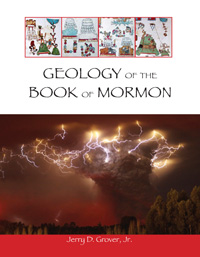Introduction
My first breath of life was taken on the extinct volcano Ko'olau. As a young missionary in Sicily I sat up late at night fascinated by the bright red incandescent lava streams moving down the slopes of Mount Etna, hearing the booms of dynamite detonated by desperate Italian geologists and engineers who were trying to divert the lava coming off the volcano to keep it from destroying homes and buildings. As a young man, I spent months traipsing through the deserts of Nevada mapping and drilling ancient volcanic deposits with the hopes of detecting traces of gold deposited in or beneath the volcanic deposits, and, shockingly, I actually found some. Without a lick of sense, I tried to see if I could keep my motorcycle upright while riding through the hurricane winds of Typhoon Alex on the streets of Taipei, Taiwan. My brief experience with natural hazards pales in comparison to the events described in 3rd Nephi in the Book of Mormon, but it has given me a great appreciation for the incredible power of nature that was put into motion two millennia ago.
For the last 30-plus years I have followed and studied with great interest the continuing development of serious studies of the Book of Mormon that try to figure out where Book of Mormon events actually took place. Over the years I have scooped up the various research and pseudoMresearch books and articles about Book of Mormon geography and culture. I have enjoyed digesting the recently released Mormon's(Codex by Dr. John L. Sorenson and other books and articles on the topic. I have long waited for an inMdepth inquiry into the implications of geology as applied to the Book of Mormon setting, but other than one brief overview article by Dr. Bart Kowallis from BYU (1997), it has not received much scientific scrutiny, nor has there been much attempt to actually look at the potential geologic locations in Mesoamerica. Do my history and qualifications as a professional geologist and a professional civil engineer mean I have any insight to offer Book of Mormon studies in this regard? The topic probably warrants a team of scientific experts analyzing the issue, but for the time being, I suppose I am as qualified as anyone to prepare a preliminary analysis of the issue. This inquiry will look at the area of the Isthmus of Tehuantepec, which for the purposes of this book will include the areas from Mexico City to the Guatemala/Honduras border. I recognize that these are not the generally accepted boundaries of the Isthmus, but I take that approach in this book for ease of reference.
The geology of the Isthmus is both a geologist's paradise and a geologist's nightmare. A paradise because there is complex geology involving everything from volcanoes to earthquakes to subduction zones to petroleum provinces. A nightmare because interfingering, overlapping volcanic deposits are difficult to identify and map. It is also a nightmare because of the subtropical climate and vegetation that tends to obscure the visual geology of formations and fault lines and erode away much of the historic volcanic geology. The first caveat with regards to this book is that it is only as good as the data upon which it relies, which in many instances has significant gaps. The second caveat is that there will be few premises that will approach the 'proven' level; many of the conclusions will involve plausibility and 'best-fit' analysis based on the available data.
This book does not set out to prove the veracity of the Book of Mormon. The Book of Mormon stands by itself and it does not need self-proclaimed experts (or perhaps worse, non-proclaimed experts like myself) professing to have a smoking gun proving or disproving the Book of Mormon. This book also does not contain multiple chapters (as many other Book of Mormon geography books do) citing endless past statements of LDS General Authorities and other LDS Church leaders as to whether any prophets knew or did not know where any particular Book of Mormon location was. My guess is that if the LDS Church knew officially where a Book of Mormon location actually was, there would no doubt already be an LDS visitors' center located there.
Finally, this book does not discuss what Joseph Smith knew or didn't know. I don't know whether or not Joseph Smith was a closet geologist way ahead of his time capable of coming up with descriptions of volcanic avalanche morphological features long before geologists recognized them after the 1980 Mount St. Helens eruption. I will leave that discussion to others, as this effort is a scientific inquiry not a theological one.
Though this is not a theological book, questions will always arise when scientific inquiries confront religious phenomena. This book explains and interprets the events and descriptions found in the Book of Mormon that have a geologic basis. This book is not an attempt to discredit the religiosity of Book of Mormon events. In the Book of Mormon itself, Jesus Christ says that he “caused” most of the events, which leaves plenty of room for the religious faithful and agnostic scientists alike, and also for the increasingly rare breed known as a religious scientist.
The first purpose of this book is to evaluate and analyze the text of the Book of Mormon itself to provide clues as to the nature and location of the disaster. The second purpose is to lay out basic Isthmus geology (and to a limited extent, meteorology) and compare the geology and natural hazards with the text of the Book of Mormon. Finally, this book will provide geographic parameters based on the underlying geology for the locations mentioned in 3rd Nephi and for some other geologic references in the Book of Mormon, and will also compare those parameters with what has become known as the “Sorenson model” of Book of Mormon geography. I will not engage in the cherry picking of various parts of the Book of Mormon to push various ideas and proposals. To be viable, the analysis must look at every word and reference in the Book of Mormon to the destruction, including prophetic references. It must address and identify all of the natural destructive methods mentioned, as well as each of the types of damage that occurred. Anything less would not forward our understanding of Book of Mormon geology.



